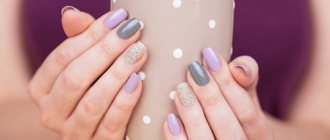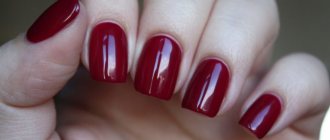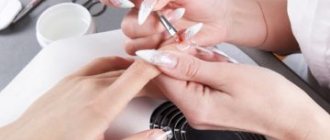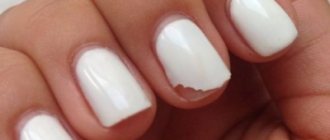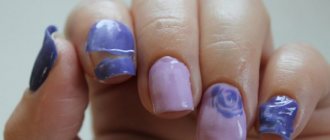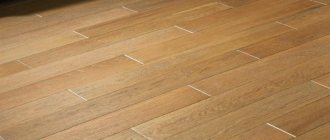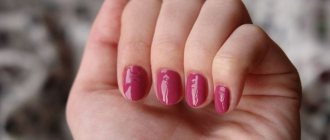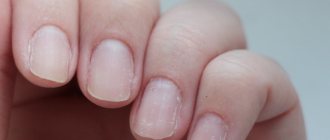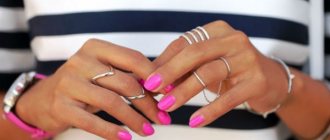The gel polish in the lamp does not dry when using counterfeit/low-quality materials, lighting equipment with low power or faulty elements, or when the lamp is heavily soiled. Professionals recommend first of all paying attention to the quality of gel polishes, especially since there is a list of materials that most often add difficulty to drying in a lamp - Noname, Lianail, Bluesky and others.
Any problems with poor drying of gel polish in a lamp can be solved: change the manufacturer of the materials, provide them with the correct storage conditions, use only powerful lamps, and so on.
Why gel polish does not dry in a lamp: errors in technology
Most often, gel polish does not dry in the lamp due to improper manicure performance (improper positioning of the hand in the lamp, a thick layer of coating, residual stickiness, etc.), problems arise among newcomers to the nail industry, because the masters are well aware of the possible provoking factors.
The hand is positioned incorrectly in the lamp
If the gel polish does not dry completely in the lamp, then you should pay attention to the position of your hand - the best option would be to dry each nail separately, but this takes too much time. Professionals carry out the drying stage of each layer taking into account the following points:
- Dry only the thumb separately;
- It’s better to place everything else in a lamp in groups of 2;
- Nails are placed to dry in the center of the light fixture;
- All fingers (except the thumbs) can be placed simultaneously in the lamp to “dry”.
And you need to make sure that your fingers are positioned inside the lamp, tightly adhering to the hard surface - even a slight misalignment can cause the gel polish to slip and not dry enough.
Too thick layer of gel polish
Each layer of coating should be thin, and novice artists try to hide imperfections in the treatment of the nail plate with a thicker layer. If there is too much gel polish on the nail, even the most powerful lamp will not be able to dry such a layer. Professionals recommend not to rush, but to apply 3-4 layers and dry each thoroughly.
An example of correct application of gel polish
Residual sticky layer
Often, beginning craftsmen complain that the top layer of gel polish, even after prolonged drying in a lamp, remains soft and pliable, although the overall polymerization of the decorative coating has taken place. This is how residual stickiness manifests itself - this phenomenon occurs often, and is corrected with a special liquid. But professionals warn that you need to use a cleaner for this manipulation, and not replace it with medical alcohol, acetone or nail polish remover.
If the general technology for performing a manicure with gel polish has been fully followed, but the top layer remains soft after drying, then you just need to moisten a cotton pad in a cleanser and wipe each nail plate - the coating will be perfect.
In addition to the reasons listed, you need to pay attention to the choice of gel polishes - there is an anti-rating for those that are difficult to dry in a lamp, even with the correct application of layers and ideal preliminary preparation of the nail plate.
Examples of bad varnishes
The most problematic gel polishes with regard to drying include:
- Noname made in China. Their popularity is due to their low cost, and even many buyers receive positive reviews about the quality of such products. But you need to understand that China produces counterfeits of well-known manufacturers and is unlikely to comply with technological processes during the manufacture of products. The result can be completely unpredictable; often the gel polish spreads, practically does not polymerize, and becomes covered with cracks.
- Gelish gel polish is a decorative coating from an American brand. In general, this material is famous for its high quality characteristics, but it also has disadvantages. For example, sometimes there are complaints from professionals that the first layer of this gel polish “curls” a little when drying, even if a branded base coat was previously applied.
And one more nuance regarding this brand of gel polish - the white color of the coating polymerizes very poorly, so you have to significantly increase the drying time in the lamp. It’s interesting that other shades of gel polishes “behave” absolutely adequately.
- Lianail is a well-known brand, its popularity at one time was simply incredible, because the quality-to-price ratio of gel polishes was simply ideal. Over time, complaints began to be received that when applying the next layer, the brush began to get dirty with the previous one, and the last one “stretched” behind the lint.
Even experienced craftsmen reported this, but a priori they could not disrupt the technology of drying gel polish in a lamp. Afterwards, professionals adapted to solve this problem by increasing the drying time of each decorative layer in the lamp.
- Ingarden - the range of gel polishes from this manufacturer is simply huge; the line always includes the most popular shades. But users often complain that when removing a sticky layer and applying a subsequent one, the previous one may shift. The solution to the problem is simple - you need to increase the drying time for each layer of decorative coating to 2 minutes. This, of course, prolongs the time of manicure, but it turns out to be of very high quality.
- Bluesky is a well-known brand, but with one caveat: light shades take much longer to dry than dark ones. In general, it is believed that the materials from this manufacturer will be easiest to use for professionals who can properly dry gel polish in a lamp with ultraviolet light.
How to prevent deformation of the gel coating
We have identified the main reasons why gel polish shrinks and ruins the entire manicure. This problem can be prevented by following these rules:
- Buy gel polishes only from well-known and trusted manufacturers . Chinese analogues and counterfeits are not always suitable for creating high-quality and durable coatings.
- As needed change the light bulbs in a UV lamp. Their resource is usually indicated in the instructions. Timely replacement of light bulbs will help polymerize the gel polish 100%.
- Apply all coatings to the nail in a thin layer . This applies to both modeling gel and colored gel polishes. By drying each layer for a minute, you can achieve a durable coating that does not deform and will last on your nails for at least 3-4 weeks.
- Follow the rules for storing gel polishes. All bottles should be placed in a box and hidden from direct sunlight.
This is interesting: why gel polish causes allergies
For more information on why gel polish shrinks in a UV lamp, watch this video:
Why does gel polish shrink, wrinkle, and curl up in the lamp?
If the gel polish shrinks, wrinkles, or curls after drying the nails in the lamp, then the reason must be sought directly in the material used:
- highly pigmented color - these will be bright, “dense” shades, in which a high concentration of pigment prevents the penetration of light rays, which prolongs the polymerization process;
- the shelf life of the gel polish has expired - it is usually calculated from the moment the bottle is opened (2 years), after this time the material not only dries poorly in the lamp, but also does not stick to the nails and can cause allergies (such residues are better used on tips);
- gel polish has not been used for a long time - the pigment in the bottle has already settled to the bottom, the composition becomes uneven, and this does not allow it to dry well, but if you carefully roll the bottle in your palms, the problem will disappear (it is strictly forbidden to shake it - bubbles will appear in the varnish, which then they will remain on the nails);
- the decorative coating was not stored correctly - the place should be dark and not hot so that the gel polish does not thicken and lies evenly on the nail plate.
Cheap gel polish, an outright fake of well-known brands, shrinks, curls and wrinkles in the lamp. That is why it is recommended to purchase truly branded decorative materials from suppliers with an impeccable reputation.
Useful tips: how to avoid gel polish defects
The following 5 recommendations will help you avoid mistakes that could cause the gel polish to swell, wrinkle, or peel off during use and after drying.
- The lamp should be positioned as conveniently as possible for the correct placement of all fingers in it, so that the ultraviolet rays hit the nail plate evenly on each side. The thumb should be dried separately in the center of the device, being careful not to tilt the nail so that the gel polish is fixed correctly.
- Improper preparation of the nail plate, namely pre-treatment of the surface not with a buff, but with a polisher, also leads to defects in the gel coating. The purpose of the buff is to create a roughness on the nail surface that will ensure good adhesion of the natural nail to the artificial gel polish. The polisher is designed to create a smooth nail plate, so when using it, the polish simply will not be able to adhere well to the surface.
- Do not rush to prepare the nail, since the surface also largely determines whether the gel polish will wrinkle.
- When applying gel polish, there should be no moisture or grease between the layers, which can be introduced, for example, by accidentally leaning a nail against your face or hands. Before coating, it is necessary to thoroughly treat the surface with a dehydrator to degrease the nail.
- To remove stickiness from the top coat or between layers, you can use a cleanser - a cleanser. You will learn about other secrets of proper application of gel coating in the article Gel Polish. Perfect alignment of one left.
If the gel polish still begins to wrinkle after drying, bubbles and swelling appear, you will have to remove them using a file or pusher. Afterwards, you need to clean the nail plate from any remaining dust and wipe it with a degreaser. After this, you can re-coat your nails with a thin layer of gel polish. Small defects can be corrected by quickly applying topcoat and fixing it by holding it under the lamp for a few seconds.
By adhering to these rules, you can create not only a beautiful manicure on your hands, but also decorate your pedicure with single-phase gel polish from the Pedicure Line UNO collection - 10 shades for a long-lasting pedicure.
Why does the lamp not dry the gel polish, it is soft after drying
If after drying the gel polish remains soft, but there are no bubbles or signs of wrinkling, then most likely the problem lies in the lamp. First of all, you need to check how correctly the light sources work - often it is enough to replace 1-2 light bulbs to restore the drying power of the gel polish.
Lamp quality
The lamp can be ultraviolet, light-emitting diode (LED) or hybrid. Professionals recommend choosing hybrid types of equipment, but beginners in the nail industry can use simple UV lamps. It is important that the lamp has a power in the range of 16-36 W, and what light elements it will be equipped with depends on the requirements of the master. The fact is that some gel polishes are dried only under LED lamps, while there are materials for drying exclusively in ultraviolet equipment.
Watch the video on how to choose a lamp for gel polish:
It should be borne in mind that on average a lamp is designed for 3 thousand hours of operation, but some equipment serves trouble-free for six months even with hyperactive use. Ultraviolet lamps wear out the most, so after 1 month of use you need to check the equipment and, if necessary, change the light elements. You can tell that the lamp's life has been exhausted by increasing the drying time of the gel polish.
Presence of contamination
The cleanliness of the lamp for drying gel polish is not only a demonstration of neatness and neatness to clients, but also the key to long-term, impeccable service of the lighting equipment. Even a slight layer of dirt and dust on the lamp can cause a decrease in the efficiency of drying the decorative coating. Professionals recommend wiping equipment daily with adhesive remover for medium levels of dirt and nail polish remover for heavy levels.
Gel polish lamp: secrets and rules of use
An ultraviolet lamp for nail art is specially designed for polymerization of gel polish coatings and the gel itself when extending nails. The quality of the final manicure directly depends on the correct choice and high quality of the device. But not only the device itself, which according to its operating principle can be LED (LED) or fluorescent (UV), affects the coating. First of all, you need to know how to handle it. Therefore, many representatives of the fair sex are concerned about the question of whether there are special rules and how exactly to use a lamp for drying gel polish so that everything turns out perfectly.
Important
In order not to wonder later why the gel polish wrinkles in the lamp, you should choose the right type of lamp for your purposes. Luminescent ones are much cheaper, can save energy and are designed for approximately ten thousand hours of continuous operation. LED lamps will cost more, but their service life can be safely multiplied by ten. They are capable of drying the coating within a few seconds, do not heat up during operation and do not lose rated power during prolonged use.
Harmful or useful
The modern market offers thousands of different models of UV and LED lamps, hundreds of manufacturers from different countries. But since the principle of operation is based on the fact that the gel polymerizes under ultraviolet rays, many questions arise, the most pressing of which remains the safety of the procedure for the human body. Is a lamp for drying gel polish harmful, can it seriously affect your health and how to protect yourself from this?
The presented screenshot shows that when any of the ultraviolet devices are operating, there is UV and X-ray radiation that is hazardous to health. Of course, in one day or even a month of use, nothing will happen to you. If we talk about years, and professional craftsmen work for at least ten to fifteen years, risk becomes a truly pressing problem.
- UV-A is a type of wave that is often used in night effects, for example, in clubs, bars, and festivals. It is safe and does not cause harm to health.
- UV-B is the wave that causes our skin to begin actively producing melanin, that is, to tan. Such waves are used in solariums and spas and can be called relatively dangerous. When used correctly and in moderation, they do not cause much harm.
- UV-C is a particularly dangerous and harmful type of wave that can not only destroy human DNA, but also lead to serious consequences, for example, the occurrence of cancer.
All types of radiation are present to varying degrees in both types of lamps for polymerization of gel polish coating. With LED radiation, things are somewhat different.
The figure shows that harmful X-ray waves are practically absent in the presence of ultraviolet radiation. But why is it not scary for humans here? The thing is that here it is in the zone of infrared radiation, which has no effect on the body. In order not to go too far into the physics of the phenomenon and the speed of photons, we can limit ourselves to a simple definition. A UV lamp can best be compared to the bright midday sun in the desert, which burns everything out, and an LED lamp to the London morning sun, barely breaking through the thick clouds.
So why not give up the harmful options and switch to a safer type of light bulbs for everyone? Maybe the gel polish does not dry in such a lamp or is it of insufficient quality and constantly breaks? All this is not true, such devices work much longer than conventional ones, and they are suitable for absolutely all types of gels. It's all about the very significant cost, which stops many consumers. But is our health worth such dubious savings? It's up to you to decide.
Many girls and women ask the question why gel polish bakes in a lamp and is it dangerous for the nail plate, will there be a serious burn and serious consequences? It is not the varnish itself that bakes, but the base, which releases heat during polymerization, due to which it adheres to the surface. There is no need to be afraid of this process, but applying too thick a base can lead to overheating and even burns. Therefore, everything needs to be done according to technology and in moderation, then problems will not arise. If the base is baking, just turn off your hand and wait until it cools down, and then repeat the procedure.
Terms of use
It's time to figure out how long to dry the varnish in an LED lamp and how exactly to do it.. First of all, you should fully follow the rules of basic safety, for example, do not grab the cord with wet hands, always keep the equipment clean, do not twist the electrical wire and drop the device.
- Read the instructions carefully, and if it is written in a foreign language that you do not know, it makes sense to translate the text yourself, for example, using an online translator. It is there that it is indicated how to maintain, clean and properly operate the lamp.
- Drops, streaks of gel polish and extension products may remain on the inner surface of the equipment. They need to be removed regularly using a solvent, which is most often included in the kit.
- Before use, you should cover the lamp with a thin sterile cloth, so the risk of infection by any microorganisms will be reduced to zero.
- If the coating needs to polymerize for more than one minute, hands should be covered with a layer of protective cream containing reflective particles (UV protection).
- In personal use once or twice a month, the device will last approximately a year or two until the bulbs need to be changed. When working with clients, it is better to do this every six to eight months.
The suitability of fluorescent lamps should not be determined by their performance and wait until they finally burn out. In order not to wonder why the gel polish does not dry, you need to understand that the power drops on its own and change the components regularly.
Exposure time
Another pressing question is how long to keep the gel polish under the lamp so that it completely polymerizes and dries. There is no definite answer to this question, but there are several basic positions that every manicurist should know, both for himself and for his dear clients.
- The base dries for about thirty seconds, which is usually quite enough.
- The standard timer for most lamps is exactly 120 seconds or two minutes. This is how the first layer of pigmented varnish dries, as well as the recoat.
- The topcoat usually dries completely in two minutes.
It is forbidden to touch the coating with your fingers or especially with your tongue until the manicure is completely completed. Much also depends on the power, for example, for a 9-watt model it is worth doubling the time, 18-36 watts the standard time is perfect, but for the most powerful 54-watt models it is better to reduce the exposure time to 30-60 seconds. Thus, you will have to experimentally find out how long to dry the gel polish in a lamp in order to get the ideal result.
How to tell if gel polish is dry and how long does it take to dry?
Gel polish does not dry for long - it is enough to keep your nails in an ultraviolet lamp for 60 seconds at a power of 36 W, if the latter figure is lower, then the time can increase to 2 minutes. But you can understand that the gel polish has really dried by the following signs:
- the coating does not shine;
- the color of the gel polish is uniform;
- when turning the finger down with the nail, there are no symptoms of “floating” of the material.
Beginners can check the degree of dryness of the decorative coating with liquid to remove the sticky layer - if no pigment remains on the cotton pad, then the process has been successfully completed.
Why doesn't the base or top coat dry?
The base and top coat may not dry if the technology of the preparatory stage is violated, because the base rests on the natural nail plate. The most important thing is to thoroughly degrease the surface so that the rays of ultraviolet lamps can penetrate the base layer and “glue” it to the nail with heat.
The top does not dry often when:
- use of low-quality materials;
- the use of LED lamps (the top dries only under ultraviolet light);
- the time the hand is in the lamp is too short.
Gel polish does not dry in the lamp: reasons and ways to prevent them
The most common reason that gel polish does not dry in the lamp is that its expiration date has expired.
The photo shows an example of expired gel polish
Manufacturers indicate that their products can be used for 2 years, but this period should be counted not from the date of manufacture, but from the moment of opening/first use. It is also important to store gel polish correctly - away from heating devices, in a dark place.
These factors most often “work” on those varnishes that have too extravagant shades or are not popular. It will not be possible to solve the problem of expiration date, but a long break in the use of a particular material makes it necessary to carefully roll it in your palms before opening the bottle. It is strictly forbidden to shake such varnishes - the pigment will be distributed unevenly in the varnish, as a result the coating will be of poor quality.
How to apply thick varnishes correctly
Many gel polishes contain a large amount of pigment - their colors are rich and bright. Professionals emphasize that such material should be applied with an absolutely dry brush and in an extremely thin layer - in general, it is better to apply 2 ultra-thin layers and dry them step by step than to get by with one “thin” one, reducing the time of the entire manicure.
If a thin layer was applied, but the gel polish still shrank and wrinkled after drying in the lamp, then this means that the thickness needs to be reduced. The application of ultra-thin layers of coating of highly pigmented materials also reduces their consumption, and at the prices of branded products this is relevant.
How to care for dryer lamps
You need to clean the equipment every day after finishing work, but change the light bulbs much less often - no more than once every 5-6 months, if you work with them every day and for 2-3 manicures.
In order for the gel polish to dry completely, you need to monitor the condition of the light elements - simply look inside the structure and identify those lamps that shine weaker or have gone out completely. This applies to all types of equipment, especially hybrid ones - if the master dries the coating for 60 seconds, then if only one element fails, the time should be increased. And if this does not happen, then the gel polish may not dry completely under the same working conditions.
What happens if you overdry gel polish in a lamp?
In general, there is no such thing as “over-drying gel polish in a lamp”, because after the decorative coating hardens, all reactions stop, further influence of ultraviolet or LED waves does not have a negative impact on the final result. Even if the nails were in the lamp for 4 minutes instead of the required 2, then subsequently there will be no chips, cracks or a decrease in “use time”.
If the gel polish does not dry in the lamp, then you need to look for the reasons in the material itself, the lamp and the rules of the process technology. The process can be affected by low power of lighting equipment, low-quality or too light/highly pigmented varnish, severe contamination of the lamp, lack of a degreasing stage of the nail surface and other factors. When eliminating “provocateurs”, the process of drying gel polish in a lamp can be adjusted to perfection.
Why and how a lamp can affect the deformation of gel polish during drying
Gel polishes as a real miracle of the nail industry have already been appreciated by millions of women who care about the health and aesthetics of their nails. Gel coating allows you to create a beautiful, long-lasting manicure and easily realize your most original ideas. And you can find new ones here: The best autumn color trends in the nail industry.
To polymerize the gel coating, ultraviolet (UV) lamps are used: fluorescent (LL), light-emitting diode (LED) and the most common - hybrid (UV/LED). In this case, drying devices often cause deformation of gel polish. The gel coating may wrinkle and become deformed for the following reasons.
Insufficient lamp power
One of the reasons why gel polish wrinkles is the insufficient power of the ultraviolet lamp. Today the market offers models with power from 9 to 90 W. Not only the polymerization time of the artificial material, but also the quality of drying depends on the power of the device.
In a low-power lamp, ultraviolet rays cannot fully penetrate the thickness of the coating, especially if the gel polish is highly pigmented or applied in a thick layer, so it does not dry well and begins to deform. To obtain high-quality coverage, the power of the device must be at least 36 W.
Worn emitting element and unsuitable lamp model
The radiation power of ultraviolet lamps decreases over time, they dim, and the radiation efficiency decreases. As a result, the varnish will take longer to dry, may wrinkle and have poor adhesion. The problem is solved by timely replacement of the radiating element. This is important to consider if the master serves a large number of clients.
Note! Luminescent elements are sensitive to shocks and changes in mains voltage, so you need to work with the LL lamp carefully.
The ultraviolet LED lamp has a longer service life than the fluorescent model. But still, LEDs lose power over time and if they fail, you will have to buy a new device, since in most models they cannot be replaced.
One of the reasons that gel polish does not dry in an LED lamp may be the incorrect placement of the LEDs in the device. As a result, blind spots are formed where insufficient UV rays reach, which leads to insufficient drying and deformation of the coating.
If a fluorescent lamp is used for drying varnishes of any type, then an LED lamp is not suitable for polymerizing gel coatings from some manufacturers. In order not to be mistaken, you need to look at the mark on the bottle, where the mark UV/LED means that the gel polish can be dried in any type of lamp, and UV Gel Polish can only be dried in an ultraviolet or hybrid lamp.
Attention should also be paid to caring for the device: periodically wipe the mirror surface from dust and dirt so that it better reflects UV rays for effective scattering.
